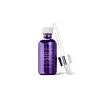What's inside
What's inside
 Key Ingredients
Key Ingredients

 Benefits
Benefits

 Concerns
Concerns

 Ingredients Side-by-side
Ingredients Side-by-side

Dimethicone
EmollientCyclopentasiloxane
EmollientCaprylyl Methicone
Skin ConditioningDimethiconol
EmollientDimethicone Crosspolymer
Emulsion StabilisingTetrahexyldecyl Ascorbate
AntioxidantDimethicone/Vinyl Dimethicone Crosspolymer
Skin ConditioningPaphiopedilum Maudiae Flower Extract
Skin ConditioningHydroxypinacolone Retinoate
Skin ConditioningBisabolol
MaskingZingiber Officinale Root Extract
MaskingCaprylic/Capric Triglyceride
MaskingDimethyl Isosorbide
SolventEthylhexyl Cocoate
EmollientGlyceryl Linoleate
EmollientGlyceryl Linolenate
EmollientTocopheryl Acetate
AntioxidantCholesterol
EmollientCeramide NP
Skin ConditioningPhenoxyethanol
PreservativeDimethicone, Cyclopentasiloxane, Caprylyl Methicone, Dimethiconol, Dimethicone Crosspolymer, Tetrahexyldecyl Ascorbate, Dimethicone/Vinyl Dimethicone Crosspolymer, Paphiopedilum Maudiae Flower Extract, Hydroxypinacolone Retinoate, Bisabolol, Zingiber Officinale Root Extract, Caprylic/Capric Triglyceride, Dimethyl Isosorbide, Ethylhexyl Cocoate, Glyceryl Linoleate, Glyceryl Linolenate, Tocopheryl Acetate, Cholesterol, Ceramide NP, Phenoxyethanol
Ingredients Explained
These ingredients are found in both products.
Ingredients higher up in an ingredient list are typically present in a larger amount.
This ingredient is an emollient, solvent, and texture enhancer. It is considered a skin-softener by helping the skin prevent moisture loss.
It helps thicken a product's formula and makes it easier to spread by dissolving clumping compounds.
Caprylic Triglyceride is made by combining glycerin with coconut oil, forming a clear liquid.
While there is an assumption Caprylic Triglyceride can clog pores due to it being derived from coconut oil, there is no research supporting this.
Learn more about Caprylic/Capric TriglycerideCyclopentasiloxane, or D5, is a silicone used to improve texture of products and trap moisture.
D5 is considered lightweight and volatile. Volatile means it evaporates quickly after application. Once evaporated, D5 leaves a thin barrier that helps keep skin hydrated.
It is also an emollient. Emollients help soften the skin and prevent water loss. Silicones create a silky texture in products. D5 helps other ingredients become more spreadable.
Studies show D5 is safe to use in skincare products. We recommend speaking with a skincare professional if you have concerns.
Learn more about CyclopentasiloxaneDimethicone Crosspolymer is a silicone created by modifying dimethicone with hydrocarbon side chains. Due to its large size, it does not penetrate skin. It is considered non-occlusive.
Dimethicone Crosspolymer is used to stabilize and thicken products. It also helps give products a silky feel.
This ingredient is a silicone used to improve the texture of products and absorb oil. It does not get absorbed into the skin.
Like other silicones, Dimethicone/Vinyl Dimethicone Crosspolymer helps condition the skin by creating a barrier. In this sense, it can act as an emollient and trap moisture in.
This ingredient is a type of elastomer.
Learn more about Dimethicone/Vinyl Dimethicone CrosspolymerDimethiconol is a silicone that resembles the popular dimethicone. Like other silicones, it is an emollient. Emollients create a thin film on skin to prevent moisture from escaping.
This ingredient helps to create a silky texture and improve spreadability. Due to its high molecular weight and thickness, it is often combined with cyclopentasiloxane.